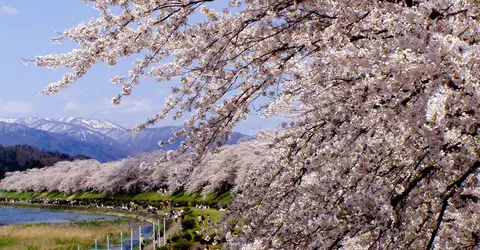Kakunodate 角館

The Sakura Tunnel by the River
Kakunodate Tourist Office
The Little Kyoto in the North of Japan
Each spring in this city in the north of Tohoku, the cherry blossoms bloom at the bottom of the black palisades hiding secret houses. Discover the history of feudal Japan through the lanes of traditional wooden houses of the magnificent samurai districts and traders of Kakunodate, some of the most well-preserved in Japan.
Immersion in feudal Japan
In the north of the main island, Honshu, Kakunodate, nicknamed “the little Kyoto of Tohoku”, is tucked away, yet quite accessible thanks to the Shinkansen’s Akita line.
Ancient samurai houses have been well-preserved and inhabited since the Edo period (1603-1868). They’re not influenced by the westernisation which took place in the Meiji era (1868-1912).
It has kept the same pace for 400 years, its quiet streets, its residential area with mysterious charm. In 1620, the Daimyo Ashina (feudal governor from the twelfth to the nineteenth century) ordered the building of a citadel north of the Senboku plain, a place surrounded by mountains, perfect for staying protected. Yet in 1656, the Satake family took the reins of the citadel and did not let them go for 200 years.
A blessing, because Kakunodate enjoyed great prosperity, becoming the political, economic and cultural centre of the Senboku region.
Samurai from another Kyoto
Tomachi, at the time inhabited by traders and artisans, is now a neighbourhood that mixes modernity and nostalgia.
Here you must try local specialities: kiritanpo (grilled rice paste), shoyu (soy sauce) ice cream and sake from pure sources in the surrounding mountains.
- To read : Soybeans in Japanese cuisine
Artisans also make art from cherry blossom bark or kaba zaiku (see photo).
Uchimachi is the district of samurai houses which you can visit to explore their secret life. They are jealously guarded by their descendants.
Come and admire the cherry blossoms (shidare zakura) in May. The story goes that three trees were brought from Kyoto by a woman promised to a samurai from Kakunodate so that she could plant them in her garden and thus remember her hometown.
Don’t be surprised to discover a city cut in half by a large square called Hiyoke. It’s been a necessity for a long time to protect the neighbourhoods of wooden samurai and trader houses from fires.

Uchimachi district
Since 1934, along the Hinokinai river, a long tunnel from cherry blossoms, or somei yoshino, extend for more than two kilometres. They were planted to celebrate the birth of the current Emperor of Japan Akihito. At the beginning of May, under the branches of cherry trees bursting with pink flowers, the edges of the river come alive.
To really enjoy it, you can rent a bike, there are lots of shops in front of the JR station. But you can also take a romantic walk, quite appropriate in such a place, or even try a jinrikisha, to immerse yourself in the atmosphere of an old era.

















